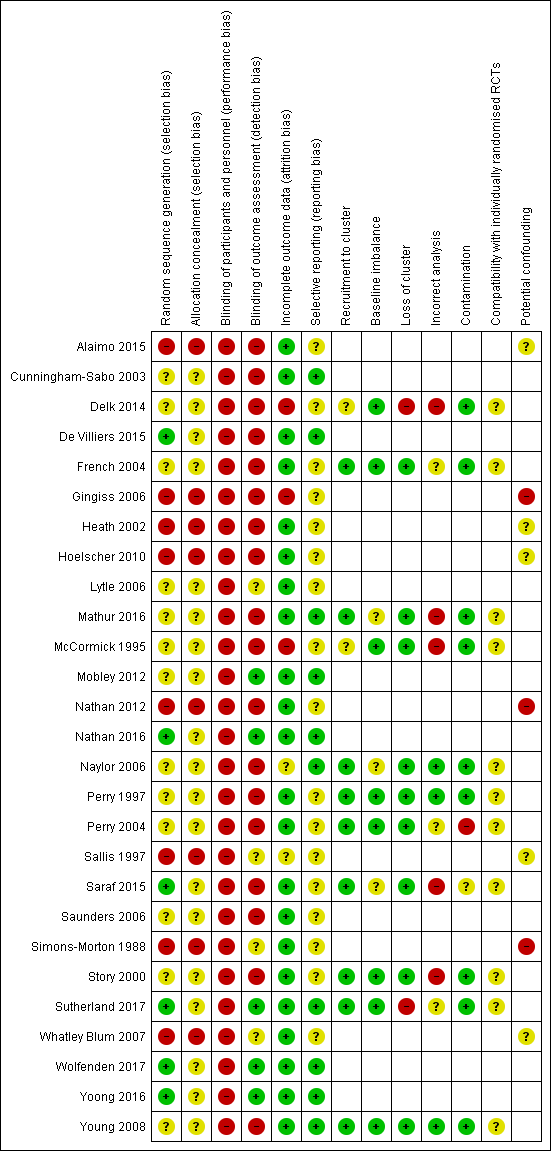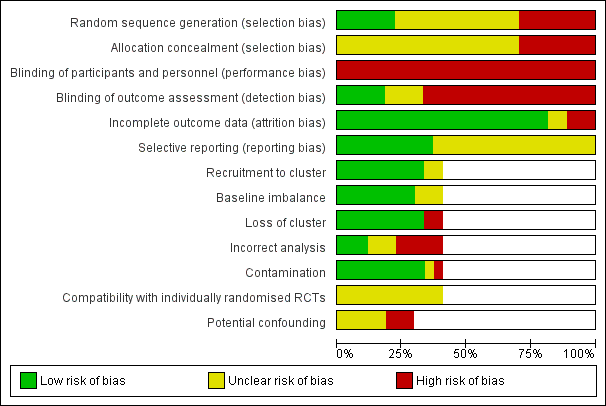| Trial | Trial name | Targeted risk factor | Implementation strategies | Comparison | Primary Implementation outcome and measures | Effect size | P < 0.05 |
| Alaimo 2015 | School Nutrition Advances Kids (SNAK) | Nutrition | Clinical practice guidelines, educational materials, educational outreach visits, external funding, local consensus processes, tailored interventions | Usual practice or waiting‐list control | Continuous: i) Nutrition policy score and ii) Nutrition education and/or practice score (2 measures) | Median (range) 0.65 (0.2 to 1.1) | 0/2 |
| Cunningham‐Sabo 2003 | Pathways | Nutritionc | Clinical practice guidelines, educational materials, educational meetings, educational outreach visits | Usual practice | Continuous: Nutrient content of school meals % of calories from fat breakfast/lunch (2 measures) | Median (range) ‐3% (‐3.3% to ‐2.7%) | 1/2 |
| De Villiers 2015 | HealthKick | Nutritionc | Local opinion leaders, educational materials, educational outreach visits, education meetings | Minimal support control | Dichotomous: % implementing a variety of policies and practices (3 measures) | Median (range) 25% (12.5% to 29.5%) | Not reported |
| Delk 2014 | No trial name | Physical activity | Local consensus process, educational meetings, clinical practice guidelines, educational outreach visits, tailored interventions, other | Different implementation strategy | Continuous: % of teachers that conducted activity breaks weekly (1 measure 2 comparisons) Dichotomous: % implementing a variety of policies and practices (2 measures 4 comparisons) | Median (range) 13.3% (11.1% to 15.4%) Median (range) 26.5% (19.4% to 31.9%) | 6/6 |
| French 2004 | Trying Alternative Cafeteria Options in Schools (TACOS) | Nutrition | Local consensus processes, tailored intervention, educational meetings, pay for performance | Usual practice or waiting‐list control | Continuous % of program implementation (5 measures) | Median (range) 33% (11% to 41%) | 5/5 |
| Gingiss 2006 | Texas Tobacco Prevention Initiative | Tobacco | Educational meetings, educational outreach visits, external funding, local consensus processes | Usual practice | Dichotomous: % implementing a variety of policies and practices (10 measures) | Median (range) 18.5% (‐1% to 59%) | 7/10 |
| Heath 2002 | El Paso Coordinated Approach to Child Health (El Paso CATCH) | Nutritionc | Educational materials, educational meetings, educational outreach visits | Usual practice | Continuous: % fat in school meal (2 measures) Sodium of school meals (2 measures) | Effect size Median (range) ‐1.7% (‐4.4% to 1%) Median (range) ‐29.5 (‐48 to ‐11) | 1/4 |
| Hoelscher 2010 | Travis County Coordinated Approach To Child Health (CATCH) Trial | Nutrition and physical activity | Educational materials, educational meetings, educational outreach visits, pay for performance, other, the use of information and communication technology, local consensus process | Different implementation strategy | Continuous: Mean number of lessons/or activities (5 measures) Dichotomous: % implementing a variety of policies and practices (2 measures) | Median (range) 0.8 (‐0.4 to 1.2) Median (range) 4.4% (3.6% to 5.2%) | 4/7 |
| Lytle 2006 | Teens Eating for Energy and Nutrition at School (TEENS) | Nutrition | Educational materials, educational meetings, local opinion leaders, local consensus processes | Usual practice or waitling‐list control | Dichotomous: % of schools offering or selling targeted foods (4 measures) | Median (range) 8.5% (4% to 12%) | 2/4 |
| Mathur 2016 | Bihar School Teachers Study (BSTS) | Tobacco | Local opinion leader, continuous quality improvement, education materials, education meeting, local consensus process | Usual practice or waiting‐list control | Dichotomous: % implementing a variety of policies and practices (2 measures) | Median (range) 56.9% (36.3% to 77.5%) | 2/2 |
| McCormick 1995 | The North Carolina School Health and Tobacco Education Project (SHTEP)/ Skills Management
and Resistance Training (SMART) | Tobacco | Educational meetings, local consensus processes, educational materials | Minimal support control | Dichotomous: % later implementation of curriculum for school district (1 measure) Continuous: Mean extent later implementation for school district (% of total curriculum activities taught) (1 measure) | Effect Size (95%CI) 16.7% (‐37.7% to 64.1%) Mean differencea 0.56% | 0/2 |
| Mobley 2012 | HEALTHY study | Nutritionc | Educational games, educational meetings, external funding, tailored intervention, educational materials, educational outreach, other, the use of information and communication technology | Usual practice or waiting‐list control | Dichotomous: % schools meeting various nutrition goals (12 measures) | Median (range) 15.5% (0% to 88%) | Not reported |
| Nathan 2012 | Good for Kids. Good for Life | Nutrition | Educational materials, educational meetings, local consensus processes, local opinion leaders, other, monitoring the performance of the delivery of the healthcare, tailored interventions | Minimal support control | Dichotomous: % Schools implementing a vegetable and fruit break (1 measure) | Mean difference (95%CI) 16.2% (5.6% to 26.8%) | 1/1 |
| Nathan 2016 | No trial name | Nutrition | Audit and feedback, continuous quality improvement, education materials, education meeting, local consensus process, local opinion leader, tailored intervention, other | Usual practice | Dichotomous: % implementing a variety of policies and practices (2 measures) | Median (range) 35.5% (30.0% to 41.1%) | 2/2 |
| Naylor 2006 | Action Schools! British Columbia (BC) | Physical activity | Educational materials, educational meetings, educational outreach meetings, local consensus process, other, tailored Interventions | Usual practice or waiting‐list control | Continuous: Minutes per week of physical activity implemented in the classroom (1 measure 2 comparisons) | Median (range) 54.9 minutes (46.4 to 63.4) | 2/2 |
| Perry 1997 | Child and Adolescent Trial for Cardiovascular Health (CATCH) | Nutrition and physical activityd | Educational materials, educational meetings, educational outreach visits, other | Usual practice or waiting‐list control | Continuous: % of kilocalories from fat in school lunch (1 measure) Mean milligrams of sodium in lunches (1 measure) Cholesterol milligrams in lunches (1 measure) Quality of PE lesson % of 7 activities observed (1 measure) | Effect size Mean difference (95%CI) ‐4.3% (‐5.8% to ‐2.8%) Mean difference (95%CI) ‐100.5 (‐167.6 to ‐33.4) Mean difference (95%CI) ‐8.3 (‐16.7 to 0.1) Mean difference (95%CI) 14.3% (11.6% to 17.0%) | 3/4 |
| Perry 2004 | The Cafeteria Power Plus project | Nutrition | Educational meetings, educational outreach visits, educational materials, local consensus processes, other | Usual practice or waiting‐list control | Continuous: % of program implementation (2 measures) Mean number of fruit and vegetables available (2 measures) | Median (range) 14% (‐2% to 30%) Median (range) 0.64 (0.48 to 0.80) | 2/4 |
| Sallis 1997 | Sports, Play, and Active Recreation for Kids (SPARK) | Physical activity | Educational materials, educational meetings, educational outreach visits, length of consultation, other | Usual practice or waiting‐list control | Continuous: Duration (minutes) per week of physical education lessons (1 measure) Frequency (per week) of physical education lessons (1 measures) | Mean difference (95%CI) 26.6 (15.3 to 37.9) Mean difference (95%CI) 0.8 (0.3 to 1.3) | 2/2 |
| Saraf 2015 | No trial name | Nutrition, physical activity and tobacco | Educational games, educational materials, educational meetings, local consensus processes, local opinion leaders, tailored Interventions, other | Usual practice | Dichotomous: % implementing a variety of policies and practices (6 measures) | Median (range) 36.9% (‐5.3% to 79.5%) | 5/6 |
| Saunders 2006 | Lifestyle Education for Activity Program (LEAP) | Physical activity | Educational materials, educational meetings, educational outreach visits, local consensus processes, local opinion leaders, other | Usual practice or waiting‐list control | Continuous: School level policy and practice related to physical activity from the school administrators perspective (9 measures) | N/Ab | Not reported |
| Simons‐Morton 1988 | Go for Health | Nutritionc | Educational materials, educational outreach visits, local consensus processes, local opinion leaders, managerial supervision, monitoring of performance, other | Usual practice | Continuous: Macronutrient content of school meals (2 measures) | N/Ab | Not reported |
| Story 2000 | 5‐a‐Day Power Plus | Nutrition | Educational meetings, other | Usual practice | Continuous: Mean number of fruit and vegetables available (2 measures) % of guidelines implemented and % of promotions held (4 measures) | Median (range) 1.15 (1 to 1.3) Median (range) 38.4% (28.5% to 43.8%) | 6/6 |
| Sutherland 2017 | Supporting Children’s Outcomes using Rewards, Exercise and Skills (SCORES) | Physical activity | Audit and feedback, education materials, education meeting, education outreach visits, local opinion leader, other | Usual practice or waiting‐list control | Dichotomous: % implementing a variety of policies and practices (2 measures) Continuous: Physical education lesson quality score (1 measures) % of program implementation (4 measures) | Median (range) 19% (16% to 22%) Mean difference 21.5a Median (range) ‐8% (‐18% to 2%) | 0/2 1/1 0/4 |
| Whatley Blum 2007 | No trial name | Nutrition | Clinical practice guidelines, educational materials, educational meetings, educational outreach visits, external funding, distribution of supplies, local consensus process, other | Usual practice or waiting‐list control | Continuous: % of food and beverage items meeting guideline nutrient and portion criteria (6 measures) | Median (range) 42.95% (15.7% to 60.6%) | 5/6 |
| Wolfenden 2017 | No trial name | Nutrition | Audit and feedback, continuous quality improvement, external funding, education materials, education meeting, education outreach visits, local consensus process, local opinion leader, tailored intervention, other | Usual practice | Dichotomous: % implementing a variety of policies and practices (2 measures) | Median (range) 66.6% (60.5% to 72.6%) | 2/2 |
| Yoong 2016 | CAFÉ | Nutrition | Audit and feedback, continuous quality improvement, education materials, tailored intervention | Usual practice | Dichotomous: % implementing a variety of policies and practices (2 measures) | Median (range) 21.6% (15.6% to 27.5%) | 0/2 |
| Young 2008 | Trial of Activity for Adolescent Girls (TAAG) | Physical activity | Education materials, education meetings, educational outreach visits, inter‐professional education, local consensus processes, local opinion leaders | Usual practice | Dichotomous: % implementing a variety of policies and practices (7 measures) Continuous: Average number of physical activity programs taught (1 measure) | Median (range) 9.3% (‐6.8% to 55.5%) Effect Size (95%CI) 5.1 (‐0.4 to10.6) | 1/8 |




